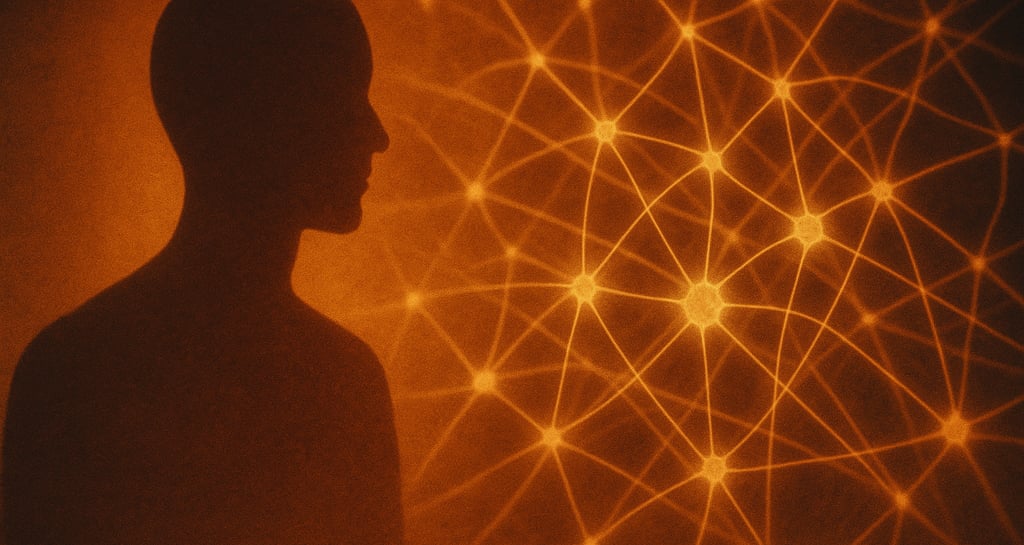You Feel the Pull — But Are You Carrying It?
Not everything that moves has direction — and not all direction is embodied. This article explores the sharp distinction between projection, direction and incarnation as physical field states. What happens when you're no longer following movement, but becoming the field itself?
POPULAR
Paul Hager
7/30/20256 min read


We live in a world obsessed with direction. We're taught to set goals, discover our purpose, stay true to our mission. The language of direction is everywhere — in coaching, therapy, career planning, even spirituality. But what do we actually mean when we speak of “having direction”? And does movement always imply real direction?
If you look closely — not with your thoughts, but from the field in which your body lives — you’ll notice something else. There’s a lot of motion, but very little actual direction. A lot of expression, but almost no embodiment. A flood of projection, but hardly any incarnation.
This article draws a clear line between those three states: projection, direction and incarnation. Not as a spiritual metaphor, but as a physical, measurable difference in the way a field behaves. Because the real question isn't what you feel, believe or want — it's how the field you're in moves. That’s where you’ll find the truth about where you are — and who you are.
1. Everything Projects — But Very Few Things Carry Direction
Projection is the most universal feature of a field. Everything projects. A rock projects its density. A tree projects its growth pattern. A human being projects their behavior, responses and emotional residue. Projection isn’t something you choose — it’s something you are. A physical effect of tension becoming temporarily visible in space.
Any field surface — in the Noöhedral model — projects itself once the tension is high enough. That’s how forms appear in space: as visible expressions of invisible interference. This applies not only to humans, but to minerals, animals, structures, sounds, memories.
Projection doesn't have to be coherent. It can be chaotic, reactive, scattered or rhythmic. It can even look beautiful — expressive, emotional, spiritual — and still lack any real direction. Because projection only shows that there is tension. Not where it's going.
The biggest mistake is assuming that whatever appears in your life, must be meaningful. But projection only reveals the state of a field. It doesn't say anything about whether that field is oriented.
We see it everywhere. A child screaming for their mother — projection. A manager micromanaging their team — projection. A spiritual seeker repeating borrowed insights — projection. It all appears, but none of it necessarily leads anywhere. And nothing about it is necessarily yours.
2. Direction — When Tension Forms an Inner Axis
Then something strange happens. A projection begins to move differently. It stops reacting and starts pulling — not from the outside, but from within. That’s when direction enters.
Direction isn’t a plan. It’s not a strategy. It’s a differential — a stable gradient of tension organizing itself into a vector. It doesn’t require your belief. It doesn’t care about your narrative. It simply starts to move in a way that feels inevitable, precise and increasingly irreversible.
You know you’ve hit direction when something “clicks” in your body, even if your mind doesn’t yet understand. It doesn’t feel like a decision. It feels like being moved. You’re not pushing forward — you’re being pulled into alignment.
Take someone who’s spent years in the same job, performing well but slowly draining. They sense it — not as pain, but as friction. Then one day, a sentence overheard in passing opens something. Not intellectually, but physically. They breathe differently. Their voice sounds clearer. Nothing has changed on the outside, but the axis has already begun to turn. The shift is subtle, but irrevocable.
Direction is exactly that: a field gradient that stabilizes before it can be explained. It doesn’t scream. It doesn’t argue. It pulls. And the body — if it listens — begins to respond before the mind catches up.
But even then, direction alone is not incarnation. Many people follow a direction for years — they write books about it, build businesses, help others — yet still live slightly outside their own spine. They move well. They just don’t carry. Because direction is motion. Incarnation is closure.
3. Incarnation — When You Become the Field Itself
Incarnation is not a metaphor. It’s not a spiritual status. It’s a physical event in the field: the moment when direction closes fully into the body — when your structure becomes the axis of tension, not just the follower of it.
You don’t just feel direction. You are it.
You breathe differently. Your tone settles. Your muscles organize along a spine that wasn’t there before. You stop performing identity. You stop managing perception. Something locks into place — not mentally, but geophysically. You become mass. Not as weight, but as field density.
That’s what incarnation is: when the vector you’ve been following finally loops through your body and anchors in your bones. It’s no longer something you “do” or “pursue”. It’s who you’ve become — physically, acoustically, behaviorally.
To reach that state, three conditions must be met:
– Field clarity — the direction is no longer drowned out by ambient noise
– Containment — your body can hold tension without leaking it
– Embodiment — your choices, rhythms and speech reflect the vector without effort
When all three converge, you become self-carried. Your field no longer depends on context or approval. Your presence holds without pressure. You stop echoing others. You become the signal.
4. Why Most People Stay in Projection (And Why That’s Okay)
Most people don’t carry direction. And that’s not because they’re lazy or unaware — it’s because projection is safer.
Projection is familiar. It keeps you moving. It lets you adapt. It gives you the illusion of forward motion without the risk of field closure. Your life may seem full of choices and changes, but underneath, the field repeats the same unresolved loops.
Direction, by contrast, creates tension. Once it appears, it disturbs everything that doesn’t align with it: your job, your habits, your identity, your relationships. That’s why people often feel direction… and then run the other way.
Incarnation is even more demanding. It doesn’t just want your attention — it wants your body. It asks that your skin, voice and nervous system begin to behave differently. That you hold tension differently. That you stop adapting and start carrying. And that’s not easy in a culture addicted to flexibility, speed and explanation.
So yes, most people remain in projection. Some flirt with direction. Very few close fully into incarnation. Not because they’re wrong — but because closure costs something.
5. Why This Matters: Work, Relationships and Healing
This isn’t just field theory. It touches every part of how we live — and it explains why so much effort leads to so little change.
In work, people follow paths that made sense at some point — but no longer resonate. They execute, perform and deliver — but they’re not carried. Their voice is slightly off. Their decisions exhaust them. Once direction returns, everything begins to shift: not just what they do, but how they do it. Less noise. More clarity. Fewer compromises.
In relationships, the pattern is even starker. People fall in love with projections. They pursue direction in each other. But once tension rises — through silence, conflict or change — the real test begins: is either of them anchored in their own field? Or are they co-regulating projection?
Incarnated people don’t blend. They resonate. They don’t fuse — they meet. And that meeting doesn’t drain, because each person stands in their own closure.
In healing, the difference becomes critical. Much of what we call illness is field distortion: direction that was blocked, tension that couldn’t stabilize, projection that calcified. In rare cases, healing happens not through treatment, but through closure. Not through belief, but through field realignment. Not metaphorically — physically.
I’ve experienced this myself. Complete remission — not through intervention, but through incarnation. Through embodying a direction so fully that the field no longer needed to protect itself through disease.
That doesn’t mean healing is always possible. But when it is, it starts with closure. Not effort. Not knowledge. Closure.
6. The Trap of Confusion — and How to See What’s Real
Confusing projection for direction is one of the most common traps in human development. People mistake preference for purpose. They call every desire a mission. They speak of their path with conviction — but their voice wavers.
The field doesn’t lie. Projection wants attention. Direction wants action. Incarnation needs nothing.
The real danger is identification. As soon as you think you’re incarnated, you’re likely not. Because incarnation doesn’t require belief. It doesn’t need your self-narrative. It just is. And when it is, you won’t need to explain it.
You’ll feel it in others, too. Projective people talk more. Directional people push more. Incarnated people… settle. They don’t resist, but they don’t bend either. They’re soft, but non-negotiable. Their stillness carries more charge than most people's ambition.
How do you spot the real thing?
Not by asking questions. But by sensing where the field closes.
Where tension loops instead of disperses.
Where the body becomes signal, not screen.
7. Where Do You Close?
Incarnation isn’t some grand achievement. It’s a micro-shift. A field closing in the body. A breath that deepens without effort. A movement that no longer needs a story.
Most people live in projection. Some align with direction. Very few close fully into embodiment. Not because they’re unworthy — but because closure requires surrender. Not passive surrender, but vectorial commitment.
So the real question isn’t:
– What’s your dream?
– What do you want to do with your life?
– What’s your calling?
The question is more precise, more physical:
Where does your field close — so deeply, so quietly — that you no longer need to explain who you are?
Not everything that moves is direction.
Not everything that feels right is embodiment.
But anything truly incarnated carries the silent weight of reality.
